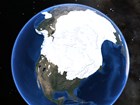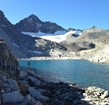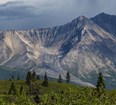Many kinds of glaciers have been important parts of our National Parks' natural history. Some parks still have glaciers today; others have been shaped by them in the past. These articles describe the different types of glaciers and where you can find them (or evidence of them!) in our Parks.
-
Article 1: Ice Sheets

Ice sheets are continental-scale bodies of ice. Although the only two modern-day ice sheets are in Greenland and Antarctica, much of northern North America--including many of our National Parks--was shaped by ice sheets during the last ice age (20,000 years ago) Read more
-
Article 2: Ice Fields and Ice Caps

Ice fields and ice caps are smaller than ice sheets (less than 50,000 sq. km or 19,305 sq. mi in area). They are also large bodies of ice that collect in high elevation catchment areas and are drained by smaller outlet glaciers. Read more
-
Article 3: Cirque and Alpine Glaciers

Alpine glaciers originate high in the mountains in many of our National Parks. When they form in small bowls with steep sides (cirques), they are known as cirque glaciers. Read more
-
Article 4: Valley and Piedmont Glaciers

Valley and piedmont glaciers originate in the high alpine and terminate on land. They often flow through deep bedrock valleys that confine the ice on either side. Over time, they carve and shape these valleys. Read more
-
Article 5: Tidewater and Freshwater Glaciers

Tidewater and freshwater glaciers are formed on land but terminate in bodies of water. They often calve to produce floating chunks of glacier ice known as icebergs. Read more
-
Article 6: Rock Glaciers

Rock glaciers are often mantled with a thick layer of rock and debris. This rock and debris shields them from ablation (melting), which means they can persist in areas where meltrates might be too high to sustain large alpine glaciers. For this reason, they can be found in many parks with high mountains in the contiguous United States. Read more
